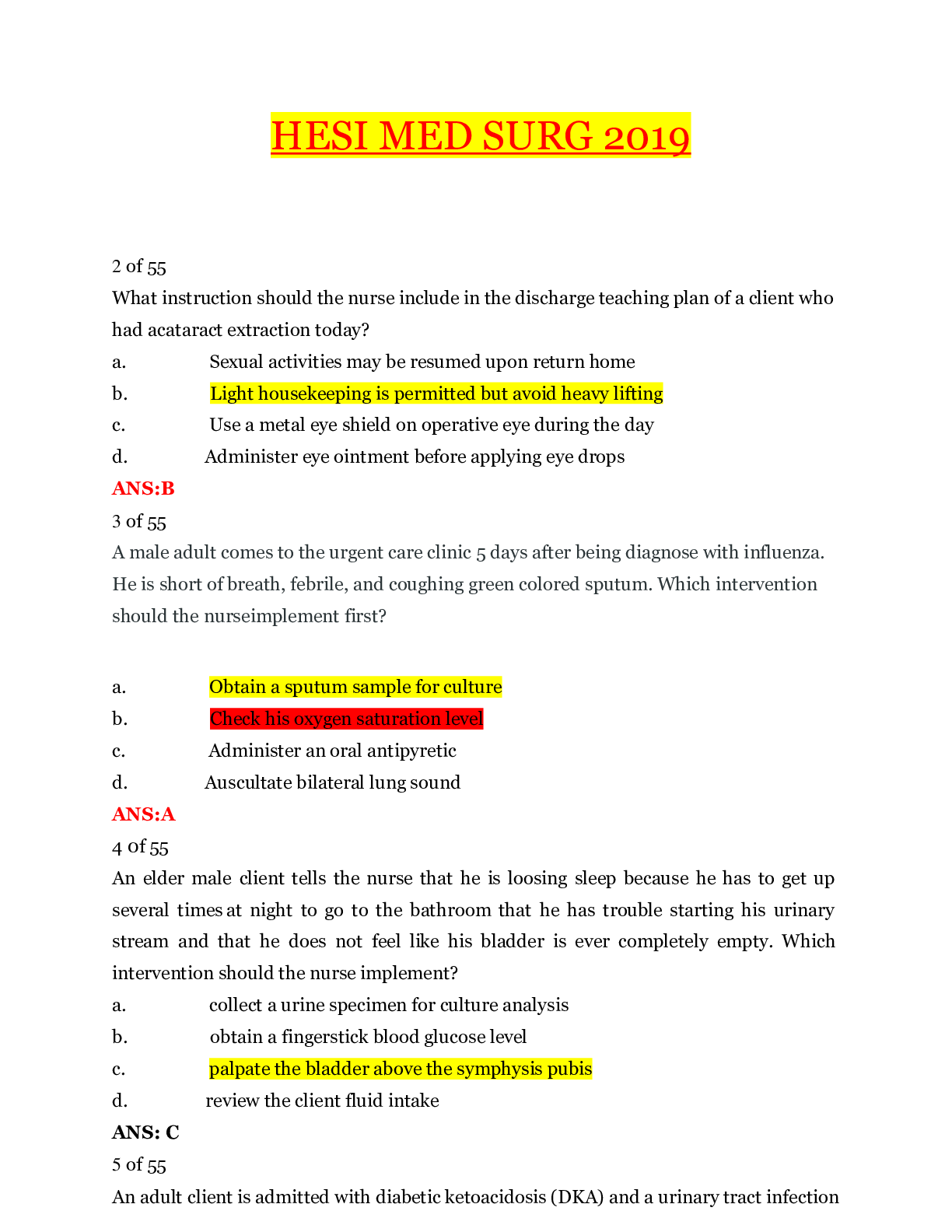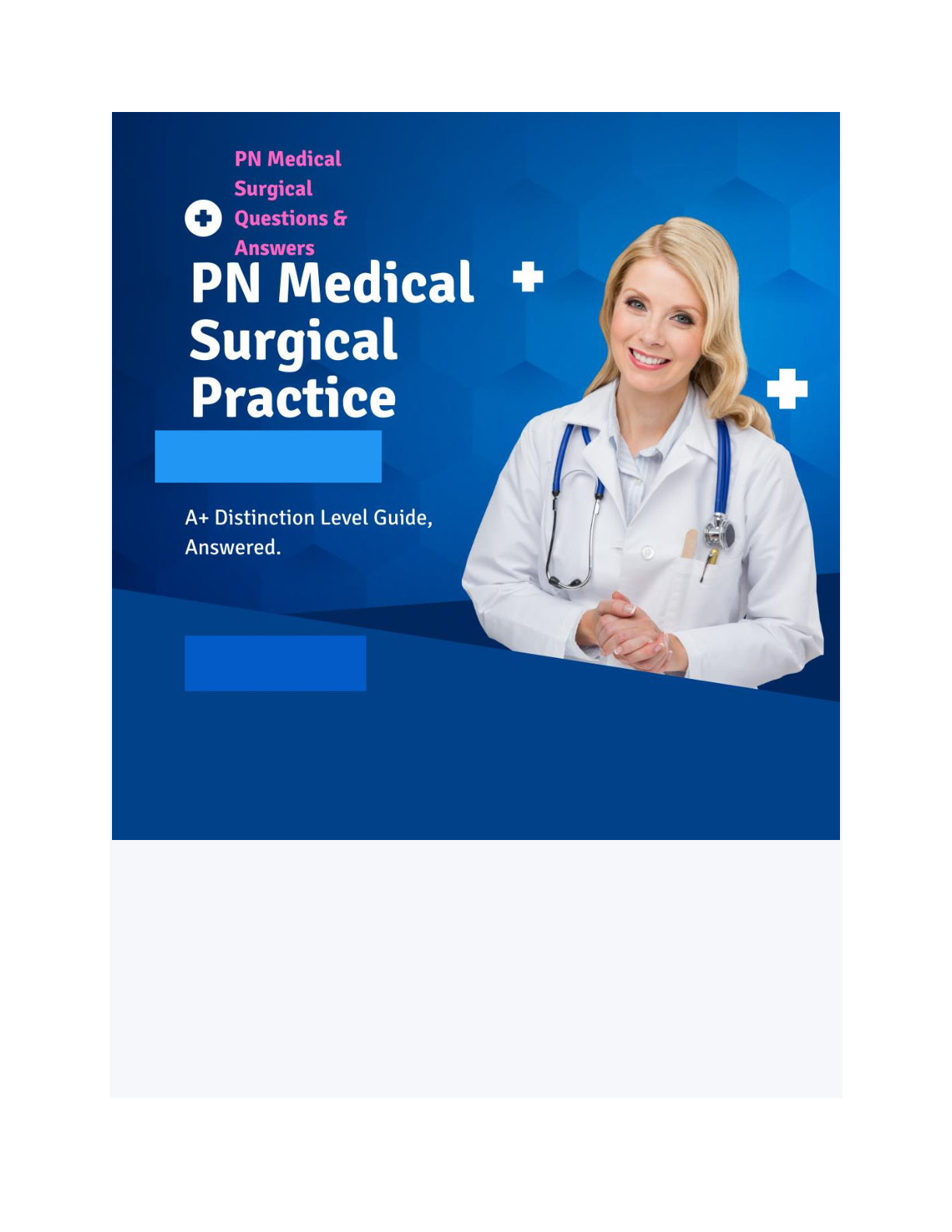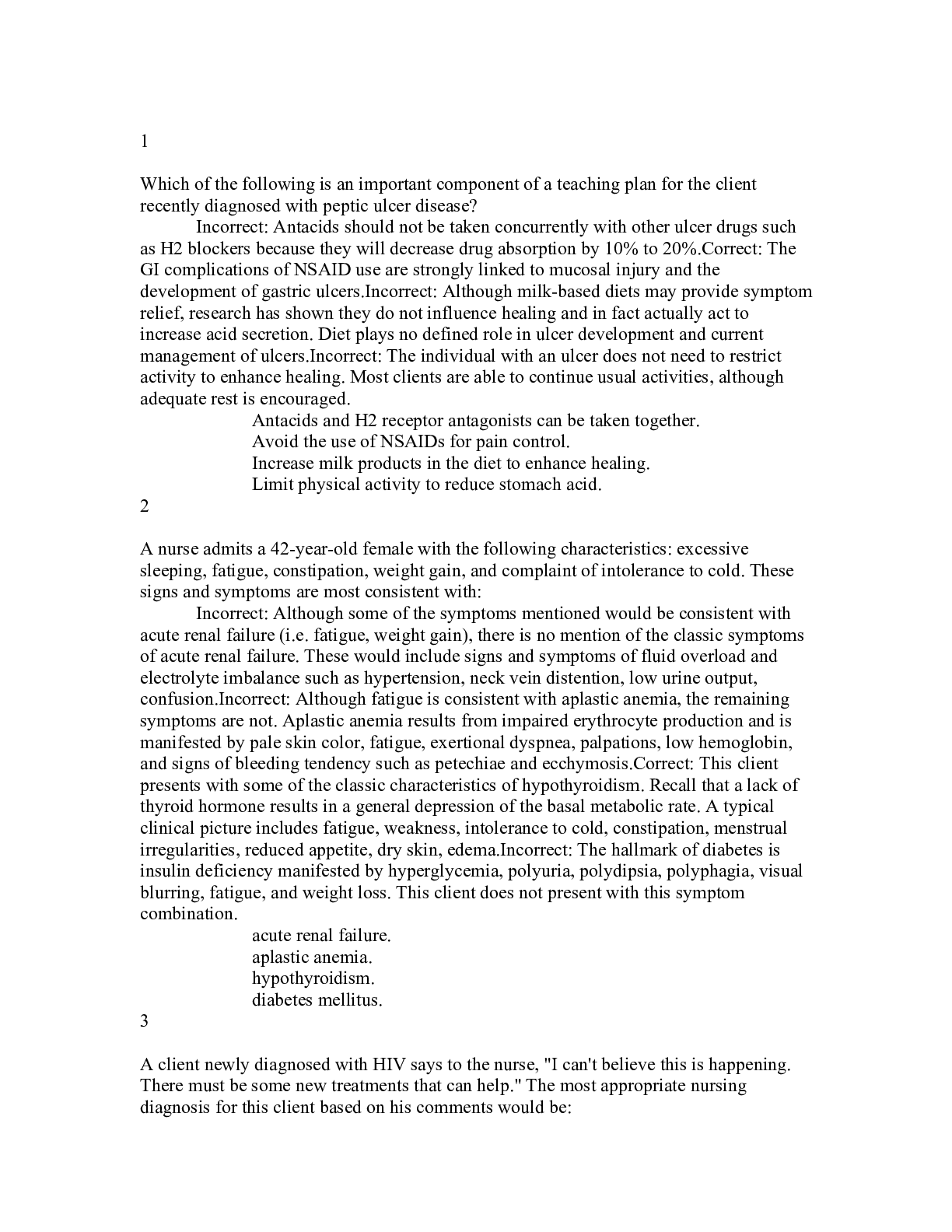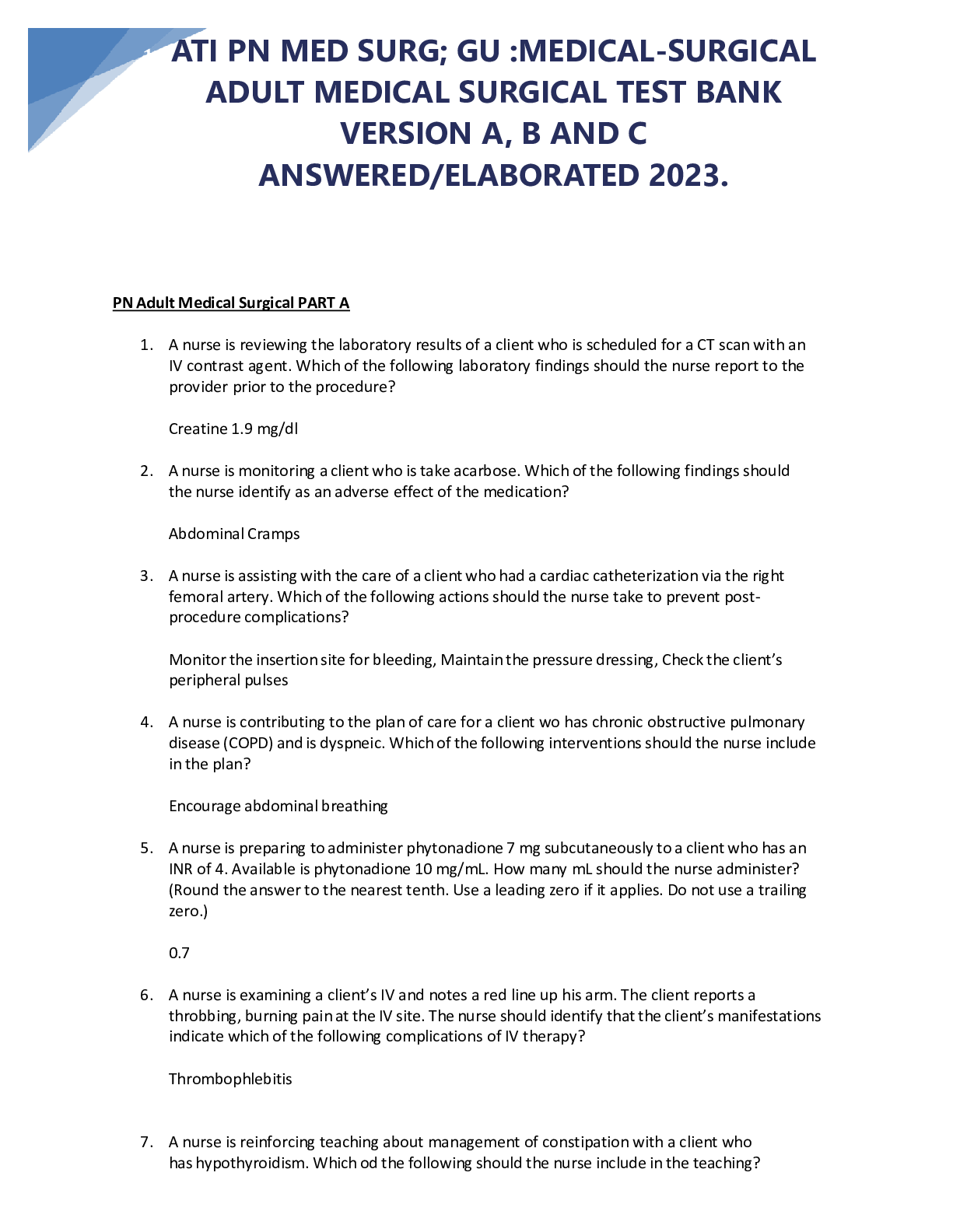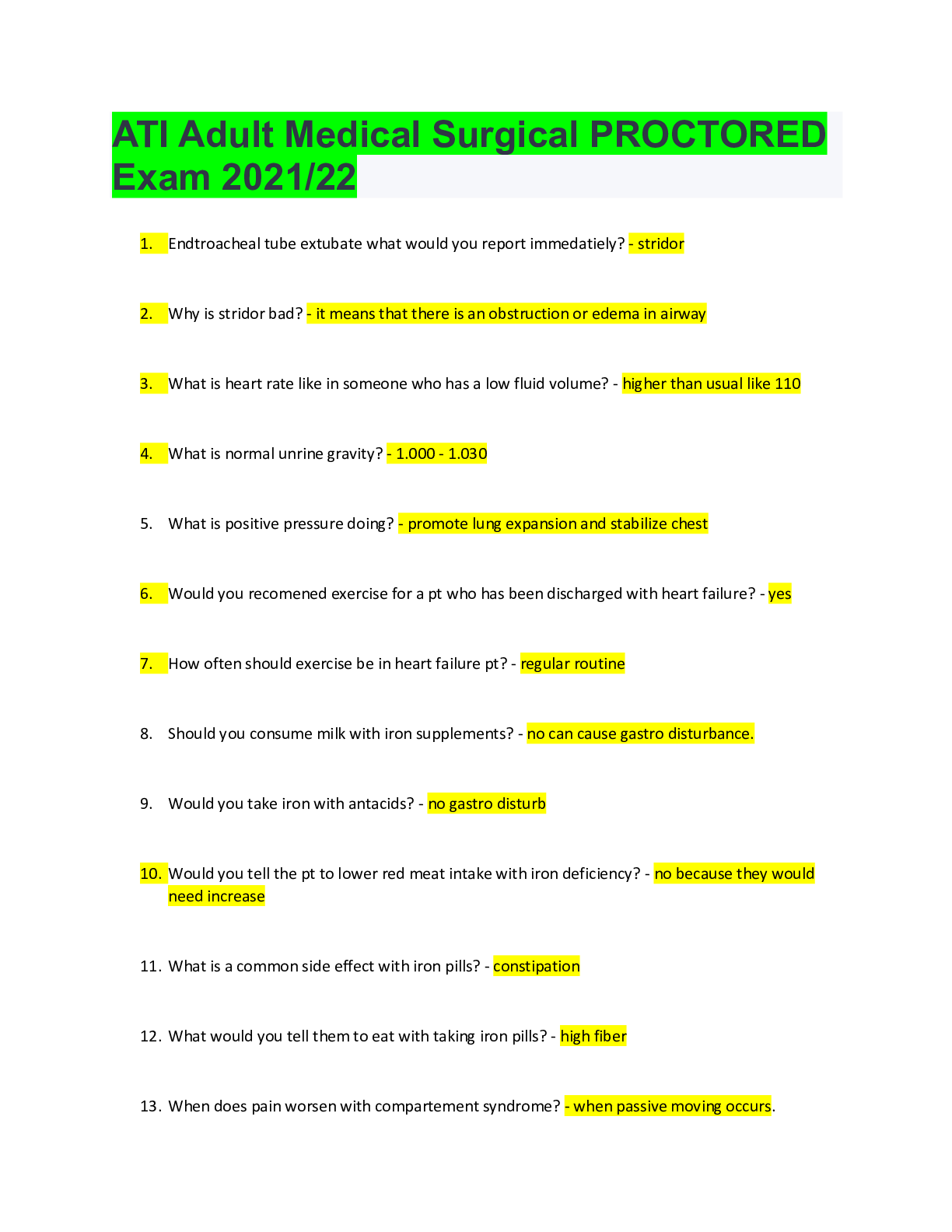*NURSING > MED-SURG EXAM > NUR 1211 Med Surg Hesi key point both semesters_Grade A | NUR1211 Med Surg Hesi key point both semes (All)
NUR 1211 Med Surg Hesi key point both semesters_Grade A | NUR1211 Med Surg Hesi key point both semesters_School Graded
Document Content and Description Below
NUR 1211 Med Surg Hesi key point both semesters Med Surg Hesi: 1- Math 2- Dash diet: Es una dieta que se utiliza para combatir el High Blood Pressure, esta basada en comer sumamente san ... o como, low fat, sodium and magnesium, high fiber. 3- Esophageal Varice Diet: Esophageal varices are swollen veins in the esophagus that are at risk of rupturing.Is usually related to an increase in pressure on the veins that deliver blood to the liver, also known as portal hypertension, and is caused by cirrhosis of the liver. Soft diet for this pte include, well done meat, dice fruit, yogurt, bananas, applea juice, vegetables, ice tea and low fat milk. 4- Hemodialysis Low BP: Process for remove wastes, such as urea, from the blood. Restore the proper balance of electrolytes in the blood. Eliminate extra fluid from the body. Esto se debe al irreversible damage to the glomeruli and nephrons, resulting in uremia. Must auscultate bruit and palpate the thrill before. Withhold hypertension meds, give insulin, takes vitals and record weight before. Risk for Hypotension and disequilibrium, S/S: peripheral paresthesia, nauseas and vomiting. (qst on the test: ans: Elevate the feet and low head of the bed) 5- Math 6- Colon Cancer-Intestinal Polyps (geriatrics): Evaluar al pte si ha tenido el o algun familiar cancer en algun otra area del cuerpo, ulcerative colitis, Crohn disease, polyps, or adenomas, tambien si usa tabaco or alcholo, si hay algun vomito o cambio en los bowels habits, como constipation, or change in the shape of stools, or blood, ask for any fatigue, anemia, unintentional weight loss, Risk factor mas communes rectal bleeding, anemia, change in the stool, hemoglobin and hematocrit are low labs. Exames para detectarlo FOBT, Barium enema, Colonoscopy. 7- Shingles- chronic pain: Causado por Varicella Zoster reactivation, este virus se mantieneen el dorsal root ganglio of sensory nerve. Evaluar por multiple lesion in segments distribution, esto aparece dias despues de sentirse con general malaise, fever, varia de minor irritation and itching discomfort, to deep pain (severe neurolagia) . Is commun complication in older adult. It is contagiosa en personas que han tenido chicken pox anteriormente, mantener airbone and contact precaution. Possible complications, necrosis, Bell ’s palsy, eye infection. TTo: Antiviral medicines, such as acyclovir, famciclovir, or valacyclovir, to reduce the pain and the duration of shingle. OTC meds acetaminophen or ibuprofen, to help reduce pain during an attack of shingles. 8- ACS-unrelieved chest pain: Acute Coronary Syndrome: = Acute myocardial infarction, evaluar labs de proteins and enzymas, troponin, creatinine, kinase and myoglobin. S/S: nauseas, diaphoresis, dysrhythmias, fatigue, palpitation, dizziness, SOB. Obtener Cardiac marker at bedside Se observa T wave inversions en el EKG, dentro de esto esta la Angina Unstable: chest pain at rest, Med Calcium Channel bloquers, Dialtezem), variant: es donde unico aparece T wave en la telemetria: Med: Nitroglycerin procedure, if pte not relieve pain apply aspirin 325 antiplatelet drugs, and call 911. Teaching, avoid extremes temperature, avoid pain, and rest. 9- Heart failure labs value: condition in which the heart is unable to pump effectively the volume of blood that is presented to it. Assess for Tachypnea, SOB, tachycardia, cyanosis, Wheezzing, pulmonary congestion, edema, weight gain, hematomegaly, Intervetions, monitorias VS, and report any sing of increasing distress, respiratory functioning, elevate head of bed, ADM O2 therapy, Digoxin and diuretics, Weight pt (diaper), maintain strictly I&O, low sodium diet. Labs electrolyte imbalance, increase of BNP (particular diastolic HF), ANP. Left side: Pulmonary edema, hypertension. Right side: circulatory problems edema, tenderness RUQ, jugular vein distention, weight gain, urinary output. 10- Myocardial infarction in females: Necrosis of myocardial walls, S/S chest pain, that radiate to the jaw, ST elevation, *in women S/S resemble idigestion, epigastric pain, nauseas, vomiting, for acute episode, Use MONA: Morphine, Oxygen, Nitro, and Aspirin. Diagnosis Troponin Enzyms, intervention, ambulation when stable, no Antibiotic for risk of fluid overload. 11- PAD ulcer, Peripheral arteria disease: Circulatory problems in veins and arteries. Stage 1: Asymptomatic, Stage 2: Claudication, Stage 3 Rest pain, Stage 4: Necrosis or gangrene. Assessment: most comun arteriosclerosis, advanced age, history of DV, Raynaud disease, Buerge disease, diabetes, embolism. Ulcers, varicose veins, shiny skin, loss of hair, brown pigment around ankle, pallor, cyanotic, Arterial (Temp-is cool) decrease pulse, Venous (Temp-is warm), normal pulse. TTO: elimination of smoking, topical antibiotic, saline dressing, bed rest, immobilization, elevation of limb. Interventions: Monitor color, temperature and sensation with pulse. Hacer actividades segun el nivel de tolerancia. No injury, wear hose, antiembolism stocking, proper nail and foot care. Meds: Heparin, warfarin, Plavix, lovenox. 12- Pheocromocytoma, endocrine: Small vascular tumor of the adrenal medulla causing irregular secretion of epinephrine and norepinephrine, leading attacks of raise blood pressure, palpitation and headache. Toas las condiciones son hyper, evaluar por possible Hypertension crisis, severe headache, palpitation, diaphoresis, flushing, apprehension, nauseas, vomiting, increase abd pressure, Urine test positive a vanillylmandelic acid, catecholamine, metaneprhine, todos se eleven en esta condicion. No se debe adm Tricyclic med, avoid food high in tyramine. 13- DVT, deep thrombosis vein: Compression stockings do not create enough pressure to prevent stasis in the deep leg veins or alter lower extremity blood flow and fibrinolysis. 14- DKA- endocrine: Uncontrolled hyperglycemia, metabolic acidosis, increases production of ketones. Is most comun in pte with Diabetes type 1, S/S, 3P, polyuria, polydipsia, polyphagia, weight loss, vomiting, abd pain, dehaydration, weakness, altered mental status, shock and coma, debido a que los Keto suben y el ph decrease causando Kussumaul respirations (deep and rapid), causando respiration alkalosis para arreglar la metabolic acidosis. Labs Serum glusoce +300, osmolarity, ketones 1-2, PH<7.35, BUN>30. Creatinine>1.5. TTO: Isotonic solution, IV fluid, check BS, and Potassium. 15- SIADH-syndrome inappropriate diuretic hormone: Interventions: Restrict fluid intake 500 to 600 ml/24h , promoting excretion of water, replacement any loss of sodium, weight gain, use hard candy or Ice ships si el ptereportased, S/S tachycardia, hypertension, dilution of hyponatremia, risk for water intoxication, confunsion, change in personality, risk for diabetes insipidus, med: demoxycline to inhibi ADH 16- Coffee ground emesis: Hepatic: Gastric ulcer, liver problems, report immediately. 17- GI surgery analgesia: Assess for gag reflex should return in 2 hours Pte may have a decrease to no peristalsis for 24 hours or may persists for several day, assess bowels in 4Q should return in 4 hours, place pt in low residual diet before and after surgery for at least 24 to 48 hours. 18- GI bleeding: Ulcer cancer, gastritis, colitis, Cronh disease, polyps, colorectal cancer, assess for hemoglobin, low immunological system. 19- Travels diarrhea (hematology): Very commun in areas with poor sanitation during warm months, ask pte to recents trips to tropical regions, check for hypokalemia S/S dehydration, give fluid replacement, Jaudince, (comun virus) E-coly.( hay una pregunta que habla de un pte de diarrhea y la respuesta es Jaundice around eyes) 20- Abecess Rash (hematology): Affects immune system, risk factor immunocompromised pte, rashes without proper treatment form into abscesses, most common cause, staphylococcus aureus, in HIV/AIDS pte, aka as Kaposi sarcoma (opportunistic infection). 21- SLE nephritis (Systemic lupus erythematous) –almost cancer: Chronic progressive inflmatory connective tissues disorders that can cause major organs and system to fail. Assess for any renal problems such as proteuniria, hematuria, fluid retention, BUN, creatinine (Pink urine, high creatinine and cloudy) . TTo: Avoid long exposure to sun, clean the skin with mild soap, Meds: Metrotexate. 22- Muscular dystrophy skin: (paralisis muscular). Progessive skeletal degeneration; genetic. Most common ducheme muscular dystrophy, risk for respiration depression (crackles, wheeszing), S/S poor balance, scoliosis, drooping eyelids, respiratory difficulty. 23- Restless leg syndrome Iron-ferrittin: Pte should be tested for iron deficiency, ferritin. A complete iron panel, including iron levels, ferritin, transferrin saturation, and total iron binding capacity. S/S: legs paresthesia (burning, prickly sensation), Especially in pte with Diabetes 2, Tto: avoiding caffeine, alcohol, no smoking, losing weight, exercising but not extremely. 24- OR banana allergies: Did you suffer any allergies for latex or any food with latex, like banana, kiwi, avocado, grape, watermelon, tomate or celery? 25- Eczema moisturizing cream: triggers, allergic reaction, avoid sunlight, keep moisturized, most common on face, higher incidence in children, TTO: corticosteroids cream after bathroom (lanolin), and must wash clothes twice to remove residue. 26- Radiation therapy avoid sun: External radiation vs internal radiation, pt must avoid sunlight, can’t rub/wash area of radiation too vigorously, always use spf 15+, brachytherapy Internal (sealed vs unsealed) *sealed given IV, PO; feces and urine is radioactive, flush twice and clean using bleach . *unsealed implant for prostate and cervical cancer, teach pt to avoid strenuous activity such as sneezing to hard, straining, heavy lifting, save all linens til end of stay because they sta radioactive, wear lead apron, remain 5-8 ft away from pte, docimeter badge required to track radiation levels and time spent with pt no more than 30 min per 24h, no minors o pregnant. 27- External fixation device-perfusion: Keep are elevate, monitor for circulatory issues, keep cast clean and dry, don’t not introduce foreign object, S/S of compartment syndrome, pain unrelieved with opioids, coolness, lack of pulse, pallor, faciotomy to relieve pressure and isometric exercise. 28- Osteomalacia priority: Is loss of bone related to a vitamin D deficiency, cause softening of bone resulting from inadequate deposit of calcium and phosphorus in the bone matrix. Demineralized bone, lack of VitmD, calcium, phosphate, parathyroid homone, level could be normal or low, alkaline phosphate high. S/S bone pain, fracture, muscle weakness, Assess: pte including age, hours exposure ot sun, skin pigmentation, history of any chronic GI disease of GI surgery. S/S bone pain or fracture, muscle weakeness, Interventions: Help pte with DMI device, to facilitate ADLs. Risk for injury always. 29- CVA expressive aphagia: Affect Broca’s area, pte generally understand but has difficulty to communicate, may become angre and frustrated. Provide repetition, notepad, board, repeat names and give 1 task at the time, can be use also body language. 30- Meningitis-action: Bacterial vs Virus, droplet preacuation for this pte, Dx: liver funtction, fluid analysis from lumbar puncture, start TTo ASAP, can remove from isolation after 24h with antibiotic, S/S photophobia (extremely sensitive to light), kerning sign (leg contraction) Risk for ICP. Intervetions: Cover mouth, disposal tissue. 31- Mutiple Sclerosis Fall: Chronic, progressive degenerative, delayed coordination of nerve impulses, cause pt to be incontinent and immobile, S/S memory and emotional changes, dysphagia, stiffness, risk for fall, keep side rails up, use DMI. Bell crock shoe 32- ALS lungs Amyotrophic lateral sclerosis: Lou Gehrig Disease: Progressive weakness muscle wasting and spasticity that eventually lead to paralysis, beginning in one area of the body, motor, weakness and deterioration spread to entire body. S/S inability to walk, swallow and breathe properly. Assess include fatigue, muscle atrophy, enlargement of organs and weakness. 33- Bone pain management: Pain reduces mobility, drop in WBC, RBC, platelets, Interventions: opioids med, maintain rest. 34- Pre-op support goal: To identify important medical issues in order to optimise their treatment. Inform the patient of the risks associated with surgery. Ensure care is provided in an appropriate environment. To identify important social issues this may have a bearing on the planned procedure and the recovery period. To familiarize the patient with the planned procedure and the hospital processes. 35- Nephrectomy post op: Assess urinary output, under welling catheter can be use, measure respiration, after this procedure pt needs Dialysis. 36- *Thoracotomy Sub-cut emphysema: Open of the thorax, S/S difficulty swallows abd inflammation (bloody). TTo: implant catheter, release air particle 37- Gonorrheal-Male: Is transmitted by Neisseria Gonorrhoeae, S/S dysuria, yellowsh-green or scant clear fluid, urethral discharge, urinary frequency. TTo: Cefriaxone sodium+ doxycycline. Intervetions: Wash hands and genital area before and after, use latex condom, use water lubricant, In man can be silent infections 38- Acute kidney injury: Rapid loss of kidneys function can be reversible, S/S urinary retention, electrolyte imbalanced, increase ammonium. Prerenal (shock), Intrarenal (acute tubular & pelvic facture), Postrenal (post disease). Can cause hypertension due to retention of fluid, edema, bUN, creatinine, and the recovery can take 2 years. 39- AGN diet instructions, Acute glomerulos nephritis: Inflamation of glomerulos, causing HTN, hematuria, *Low sodium diet. 40- Bronchoscopy prep: *NPO 6h before, hold anticoagulants 7 days before. Tube inserted by nose, ask about latex allergies, iodine allergies. Post op to alleviate sore throat do warm saline gargles. 41- COPD-infection: Can’t give more than 3L of O2, (O2 sat >86%). S/S barrel chest, wheezing, crackles, weight loss, pick puffer, pursed-lip breathing. At risk for infection so avoid crowd place, strong detergent, smoking. TTo: Influence and pneumonia vaccine, antibiotic prophylactic, bronchodilators, corticosteroid, O2 therapy, weight frequently. 42- Influenza sputum: Highly contagious, S/S sudden onset of fever, headache, fatigue, weakness, anorexia, sore throat. TTo: tamiflu, noting to sweet, no milk, no spicy food. 43- Laryngectomy track care/ Tube has a large lumen, S/S of bleeding, occlusion, which are the greatest immediate post-op risk, * Cleaning the inner cannula, suctioning, and applying clean dressings. Keep bed in semi-fowler position all time. Keep laryngeal airway humidified, auscultate lungs every 2 or 4h, provide care every 2h or 4h / or PRN. 44- Suctioning: 45- Cataract Surgery: Opacity in lens, S/S blurred vision, diplopia, absence of red reflex. Post ops, no strenuous mov, avoid bend head, sneezing, sleep on oppositive side of operate eye, pain and redness must be reported. Eyes drop: Antibiotics, Lubricants, Antiflamatory. Wear cataract glasses, 46- Diabetes Mellitus, poor compliance: Labs of A1c (presence confirms existence of hyperglycemia in previous 4 months): lower 7-8, Fair 9-10, S/S high blood sugar levels, emotional events, +K. 47- Transfusion reaction-process: Blood can’t be out of bank more than 30 min, RN is the only who can do this, must stay with pte first 15 min to monitor for signs of reaction (back pain, SOB, fever, urticaria). Interventions 1ra: Stop the infusion, next give IV bolus fluid, change tubing with every new bag, Risk for hyperkalemia. 48- Burn cultural: Some pte don’t accept animal transplant, inform always before. Qts Pte Jewsih graft, ASN: inform to client is of an animal. 49- BPS-nsg problems: S/S: frequency, urgency, dribbling, nocturia, hesitancy, bladders, and distention. PSA elevated, proceed to digital rectal exam, and confirm with biopsy. Avoid, anthicolinergics, antihistaminic meds. No coffee, med Tamsulosin. 50- Chronic back pain post op: Interventions, backup rub massage, warm compressive, med analgesic (TYLENOL, avoid ACE inhibitor). 51- Exophtalmos (hyper-pharathoydism) POC: Provide lubricant to eyes, explain to pte that eyes never will go back to the normal size, 52- Glaucome teaching: Increased intraocular pressure (IOP) >22mm Hg. Can be painless, vision loss, *Teaching adm drops as prescribed (used to cause pupil contricction bc movment of muscle to constrict the pupil, also allows aqueaous humor to flow out. Pilocarpine, is most common use, pte may be blurred vision for 1 to 2 hours). Wash hand and external eye, tild head back slightly instill drop into lowerd lid, witouth touching the lind with the tip of the dropper, close eye gently and leave closed to 3 of 5 min, apply gently pressure to the inner cantus to decrease systemic absorption. Remove rugs, adjust light. 53- Glucose monitors selection: How to use Glucometer. Gently squeeze or massage your finger until a drop of blood forms. Pinchar y limpiar first blood. Touch and hold the edge of the test strip to the drop of blood. No sharing your device. 54- Raynaud Self care: Vasospasm of arteries, triggered by cold environment, S/S numbness, tingling, coolness, Intervetions: Use warm clothing, such as socks, slipper, and not to use external heat source such as electric heating pads. 55- Seizure teaching Care: Record time and duration, and any visual disturbances during episode,*Home care install shower bars, O2 theraoy, suctioning, always turn pt on their side and minimize strobing light and noise. Key point from the last semester: 1- Carpal tunnel syndrome: Pte suffer injury in the median nerve, S/S pain, numbness, tingling, lack of ROM, extra articular features (deformities), Dx test: Phallen’s test-hand in front of the chest and tinnial test: putting pressure on nerve. Intervention: Rest, splint, cool, compresses when swollen, analgesic, with NSAIDS meds. 2- Addison’s disease: (adrenal cortex hormones), hyposecretion of Glucocorticoids, and mineralcorticoids, S/S hypotension, hyponatremia, hypoglycemia, hyperkalemia, and hypercalcemia. *Can be acute as well, resulting in cardiac arrest. 3- DM type 1 (insulin dependent): At risk for ketonuria and ketoacidsis S/S of ketoacidosis= hyperglycemia, 3 P, rapid shallow respirations, fruity breath, dehydration. Monitor Potassium,*Foot Care: Inspect daily, avoid thermal injuries, and never apply lotion between toes. * Peripheral neuropathy relates DM 2, S/S pain, pallor, parsthesia, pulsessness, cool skin, leg cramps. 4- Small bowel obstruction: S/S hyperactive, bowel sound in upper quadrants and absent on lower quadrants, statorrhea (foul smelling feces) and constipation alternating. Place pt in NPO status with regular suctioning if no improvement in 8-10 h, pt will need surgery. Intervetions: give IV fluids, suctioning, reposition every 2 hours. * Intussusceptions is most common cause of bowel obstruction (when the small and large intestine converge) 5- Hepatic Cirrhosis: S/S same as hepatitis, hematomesis (vomiting blood), yellow skin & sclera, white stool, ascites, coagulation affected, low hemoglobin/hematocrit/albumin, high live enzymes. Also prone to portal hypertension which can result in esophageal varices (increased risk for bleeding), Risk factor viral hepatitis, biliary obstruction, alcoholism. *Assess for bleeding and change in mentation, also prone to ascites, assess for breathing, measure abdominal girth daily. TTo paracentisis. 6- Gout: High purine and uric acids result in crystallization in the joints, lack of circulation, must protect toe area, TTo: Acute stage, provenicid, corchicin, chronic stage: Allopurinol.( a long term this med, cause Glaucoma) 7- Malignant Hyperthermia: Complications post op, metabolic rate and temp go up and the O2 decreases. S/S: respiratory problems, TTo: Dantrol given by IV Bolus. 8- TURP- discharge plan: For prostate cancer BPH, has 3 lumen catheters for CBI (continuous bladder irrigation), risk for water intoxication. 9- UTI’s 1st to do: S/S: burning when urinating, frequency, cloudy urine, take culture and sensitivity testing; urinalysis. 10- HHNS (hyperglycemic, hypersmolar nonketotic syndrome) most frequent in pte with DM 1, S/S same as ketoacidosi except for kassmaul respirations, acetone smell on breath, and brain coma. 11- Hypothyroidismo Lab levels: T3 and T4 are low, complication myxedema. 12- Respiration Alkalosis: Ph is elevated >7.45, carbon dioxide is low <35, cause anxiety, stress, pain, exercise, hyperventilation. 13- Peptic ulcer: Gastric: Epigastric pain, more pain with food intake, hemoemesis, trigger: coffee, NSAIDs, steroid, can become cancer and require gastrectomy ( canlead to less instrisic factor and B 12 which leads to the complication of dumping syndrome.. interventions: for dumping syndrome; lie down after meals, drink fluid on between meals, low carb diet./ Duodenum: weight gain, pain is alleviated by food intake, bleeding from rectum. 14- Bone remolding: Osteoblast & Osteooclasts. 15- ABGs report: Ph: 7.35-7.45…… PCO2 35-45 ……. PO2 80-100………..HCO3: 21-28. 16- SBAR initiate process: Situation, Background, Assessment, and Recommendation. 17- HIV/AIDS- PCP, teaching: Pneumonia carini, opportunistic infection, standard precautions, sulfa drugs. 18- Uroliathiasis-lithotripsy: (Urinary system stones), and (litho)…..process in which can destroy the stone but using extracorporeal technique. (dando golpe en la piel). 19- Venous leg ulcers: Maleolus area (ankle) related to venous insuffiency. S/S warm skin, purple discoloration of lower extremities, painless, big circumference, irregular shape, brownish. [Show More]
Last updated: 3 years ago
Preview 1 out of 11 pages

Buy this document to get the full access instantly
Instant Download Access after purchase
Buy NowInstant download
We Accept:

Reviews( 0 )
$10.50
Can't find what you want? Try our AI powered Search
Document information
Connected school, study & course
About the document
Uploaded On
Feb 11, 2021
Number of pages
11
Written in
All
Additional information
This document has been written for:
Uploaded
Feb 11, 2021
Downloads
0
Views
136




